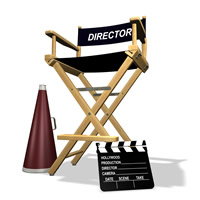Marketing Guides
Campaigns & Execution
Presentation Tip: Create a Storyboard That Sells
 In my last post I wrote about giving your next presentation a plot. Whether you’re trying to persuade one person or a thousand, you need to grab attention, build value and close with something meaningful and exciting.
In my last post I wrote about giving your next presentation a plot. Whether you’re trying to persuade one person or a thousand, you need to grab attention, build value and close with something meaningful and exciting.
Just like your favorite filmmaker!
Today I’ve got tips about storyboarding. When you create a storyboard instead of just typing bullets into PowerPoint, you can really map out your plot and create a more compelling flow for your presentation.
If you’ve developed TV spots, videos or major websites, you’ve done this before. You probably used huge boards filled with drawings to help the entire production team visualize your key points.
To create your storyboards, start with a pile of paper and colored markers. And if you’re creating a sales presentation, grab a few sales & marketing team members to collaborate.
Here’s the process I use:
1. List (or draw!) your audience members on the first sheet. During the entire presentation, they’re going to be thinking “What’s in it for me (WIIFM)?” You want to create a presentation that answers that question.
2. What action do you want your audience to take when you’re done? Write it on another sheet and add a giant “B.”
3. Grab three more sheets and come up with three key benefits that your audience members will realize when they take action. These benefits should be meaningful — your audience needs to care about them. Again, they’re thinking “WIIFM?” List one WIIFM per sheet.
4. What’s the biggest benefit that can get your audience really excited about your topic? Write it down and add a giant “A.” You’ll create a hook around this point.
Now organize your sheets so they look like this:
.jpg)
Now you’re ready to get to the meat of your presentation. Your mission:
- Grab their attention with the hook (A).
- Tell a story that takes them on a journey that addresses their three key needs (1-3).
- End with a conclusion that gets them excited about taking action (B).
To plan the detailed “plot points” for the heart of your story, list two or three major benefits or supporting points for each of the three WIIFMs. Write each one on a separate sheet, then narrow the list down to create only ten slides (that’s the “10” in Guy Kawasaki’s The 10-20-30 Rule of PowerPoint). You’ll force yourself to stick to the most important points and save yourself from going overboard on the bullets.
Your storyboard should now look like this:
.jpg)
Follow your story through the arrows. Does it flow logically so it’s easy for you to remember and explain without tons of notes? Will your audience find it interesting? Convincing? If not, move things around or change your bullet points until you can confidently say yes, I can comfortably deliver this presentation and the audience should respond to the story.
Once you have this structure in place, put on your director’s hat again. Instead of filling up each slide with text (no smaller than 30 points, says Kawasaki), try to come up with a simple visual that represents the point you want to make in each slide.
There are so many reasons to create visuals rather than bulleted lists:
- They’re more memorable for your audience
- They create interest and intrigue
- You won’t be forced to read, which kills the drama
You don’t have to be a graphics whiz to create your visuals. You could use
- A photo with a headline (get inexpensive photos from BigStockPhoto). It can be any photo that represents your concept, not just a product shot or a bunch of smiling people around a table.
- A few boxes and arrows from the PowerPoint graphics menu.
- Screen shots of web pages showing the latest news, trends, competitive info, etc.
When you truly can’t show your point with a graphic, then use bullets, but stick with very short phrases and 30-point type.
At this point you’re ready to rehearse! And if you’ve structured it effectively, you should only need a few run-throughs. Just make sure you remember how to transition from each key point to the next.
Voila! This process may have taken some time, but the results should be worth the extra effort. After all, you need to be strong, memorable, comfortable and persuasive. With a great plot and story structure, you’ve tackled the hardest part.
And if you really need to create a fantastic presentation, get yourself a copy of Jerry Weissman’s “Presenting to Win: The Art of Telling Your Story.” It offers detailed flow structures for a variety of presentation topics and is really a must-read for executives, entrepreneurs, salespeople and marketers who need to capture an audience.
Here’s some more additional reading:
- Guy Kawasaki’s “The 10-20-30 Rule of PowerPoint”
- Ruth Sherman’s tips on technical issues
Good luck!
PRESENTATION PLANNING TEMPLATES / MARKETING PLANS / PROJECT MANAGEMENT
EVERYTHING YOU NEED FOR YOUR MARKETING PROJECT